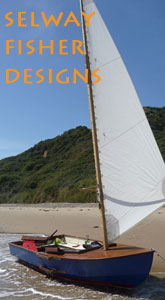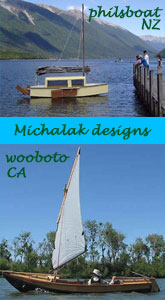Pat has built 30+ boats and written several articles for Duckworks magazine.
Ever since Dave Lucas published the "foam boat" building antics of the boys at the Tiki Hut in Bradenton, Florida, I've been intrigued by them. I have actually visited the Tiki Hut twice to see the process and the boats. Its nearly 550 miles south of here so I obviously wanted some first hand knowledge of what we going on. Dave claimed that it was super quick, easy and still made for good boats. I've been building boats for 20+ years and was skeptical of anything that could be built in less than a week and still be safe to use in the water without it rotting from under me as I did.
Fast forward a couple months after my last visit to the Tiki Hut, I visited Home Depot to buy some Styrofoam only to find out they no longer carry it (at least in my area). As I was asking about it at the Help-Desk a guy near me handed me a card and told me he could get me what I needed. Turns out he Owns a sign making business and they use a CNC Router to cut out pieces of styrofoam and then spray them with a polyurethane spray to harden them up to be durable enough to use as a sign. Anyway, he told me to let him know the dimensions and he would order a piece for me. He charged me $45 for a piece of "1-pound density" Styrofoam 12'X32"X3.5". I had chosen that size because I figured it would take that much to support my 240 pounds without being underwater. The foam blank weighed about 7.5 pounds.
I carefully transported the fragile foam to my shop. In the raw stage the foam will get dings and scrapes in it very easily so it requires extreme care till it gets some epoxy on it. Using a batten I drew a shape on the board and with a jigsaw I cut a round shape on the front end and left the square the back corners using a Jigsaw and finished within 15 minutes. Using a 1/2" sheet sander I tenderly (is that possible with a 1/2" sheet sander?) sanded the front 2 feet of the board to have a little curve making the very tip of the bow about and inch and a half thinner than the rest of the board. I was able to sand the 1.5 inches off the front in about 5 minutes of careful sanding cause the foam is very soft. It provided a very little bit of rocker up front just in case it would help. After that I blew off the dust (about the same size dust as wood sanding would provide and about the same amount). I got my epoxy and tools ready and using a squeegee and a small disposable roller I applied a layer of 6oz 38" wide fiberglass cloth wrapping it over both sides. I had bought 38 inch wide cloth so it draped over the entire side of the board and just barely wrapped under the board. I waited till the following morning to flip the board and sand the rough edge of the cloth before applying a coat to that side as well. 2 more mornings and the board had 2 layers of cloth over it and 4 layers over the sides (Almost $100 for the cloth and $75 for a gallon of epoxy & hardener). At that point I had about 8 hours invested in the build and a Board that was all but ready to be used. Total cost just over $200.
 |
 |
The beers that appear in most of the photos were accidents. I actually don't drink......much;-)
I knew I needed some way to tie stuff to the board and to be able to tie it down to transport it. After a little thought I decided to fiberglass some PVC horizontally to the board. That would allow a lanyard through to use for the aforementioned needs. It would also offer a potential opportunity to slip another piece of pipe or dowel through it to use as an axle like place to apply wheels, fins, backstays for a sail, flip up or down seat. I applied a quick coat of primer and one coat of Rustolium-Topsider paint that is sells for $11 a quart at Lowes along the coast here in Florida.
The Board was now ready for sea trials and I may have had 12 or 13 hours invested. I did use the lanyard through and between the PVC in the front and aft ending up with a line to grab and tie stuff to. I slipped some line through some pieces of a pool-noodle and tied them between the 2 fore and aft tie-down lines. This provided adjustable pads to use when car topping the boards. Just slide them to the position needed and you have instant padding. For sea trials I used a temporary tracking oar I had that was made from a trolling motor mount and a plastic paddle. I also fashioned a removable seat so I could try paddling it like a kayak as well as standing up. I made an oar for standing up and took along a canoe paddle for sitting down. I fashioned a seat that simply sat on a welcome mat on the board making it easy to install and remove when needed. The welcome mat also served as the non-skid when standing. I used a small pieces of line and poked a hole in the mat to tie it to the tie down lines to keep it with the board in case I fell off.
The board worked great and I was able to stand up almost 57 minutes per hour with the missing 3 minutes being in the water trying to get back aboard. The good news is even I was able to reboard the SUP from water deeper than me. Back at the shoreline I sat the removable seat on it and paddled it like a Kayak. It was so stable I would venture to say it would have required a purposeful effort to fall off or flip in sit-down mode. I decided my next one would be a little smaller and maybe make the bow pointed instead of round in case I took it out in the chop and needed to part the water. At the speeds I experienced I decided there was little to be gained by adding any rocker to the shape other than the slight upward shape I had sanded in the bottom of the bow.
I went back to me sign making friend and ordered an 11'X32"X3" slab of styrofoam. I had figured a foot short and a 1/2 inch thinner than the prototype would still be more than enough to keep me afloat. In the same 8 hours or so I was able to cut it out and apply 2 layers of 6 oz fiberglass cloth to the new board. I had made the bow more pointed to part the waves and curved the aft corners instead of leaving them square. Otherwise, it was very similar to the prototype. I ended up opting for a fin system the simply straddled the board to it could be slip forward and used as lee-boards if I added a sail of some sort in the future. The fin system was easily removed for transport making the board in transportation-mode a simple flat slab with nothing protruding other than the PVC tie down system.
 |
 |
 |
The finished board weighed just over 25 pounds without the removable seat & fin system. The board was large enough to support me and virtually impossible to flip in sit-down mode. It seemed slow but I'm not an SUP kinda guy so it is likely as fast as other SUPs which is disappointing for a sailor or motorboat guy (me). Still, in "sit-down" mode it is fast enough to explore the shoreline a bit even though I wouldn't want to have to paddle far upwind/against a current.
I have nearly finished an identical SUP like the one with me in the water above and will attempt to use the tube system to join them and then try attaching a trolling motor for sea trials before stepping up to a 5hp and trying to act like a Bubba(ish) Craig Cat! I'm also working on a sail system for both single and double SUPs. I have also been toying with hinging on in the middle to make it easier to transport.
|













